YAMAHA WR 250R 2012 Repair Manual
Manufacturer: YAMAHA, Model Year: 2012, Model line: WR 250R, Model: YAMAHA WR 250R 2012Pages: 98, PDF Size: 2.57 MB
Page 61 of 98
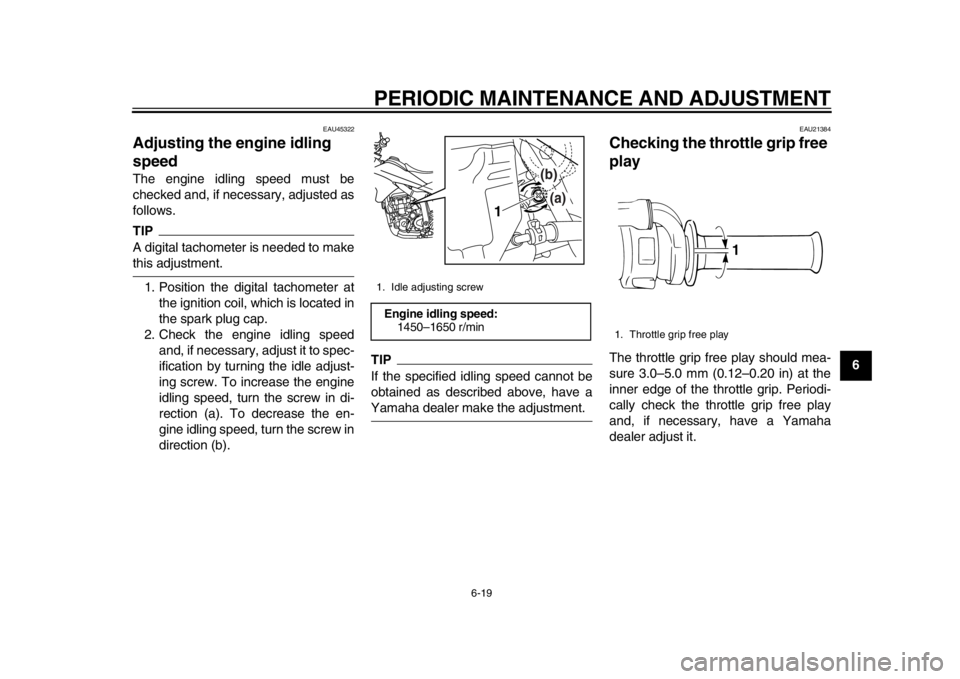
PERIODIC MAINTENANCE AND ADJUSTMENT
6-19
2
3
4
567
8
9
EAU45322
Adjusting the engine idling
speed The engine idling speed must be
checked and, if necessary, adjusted as
follows.TIPA digital tachometer is needed to makethis adjustment.1. Position the digital tachometer at the ignition coil, which is located in
the spark plug cap.
2. Check the engine idling speed and, if necessary, adjust it to spec-
ification by turning the idle adjust-
ing screw. To increase the engine
idling speed, turn the screw in di-
rection (a). To decrease the en-
gine idling speed, turn the screw in
direction (b).
TIPIf the specified idling speed cannot be
obtained as described above, have aYamaha dealer make the adjustment.
EAU21384
Checking the throttle grip free
play The throttle grip free play should mea-
sure 3.0– 5.0 mm (0.12 –0.20 in) at the
inner edge of the throttle grip. Periodi-
cally check the throttle grip free play
and, if necessary, have a Yamaha
dealer adjust it.
1. Idle adjusting screwEngine idling speed: 1450– 1650 r/min
1
(b)
(a)
1. Throttle grip free play
1
32D-9-E8.book 19 ページ 2011年6月28日 火曜日 午前10時27分
Page 62 of 98
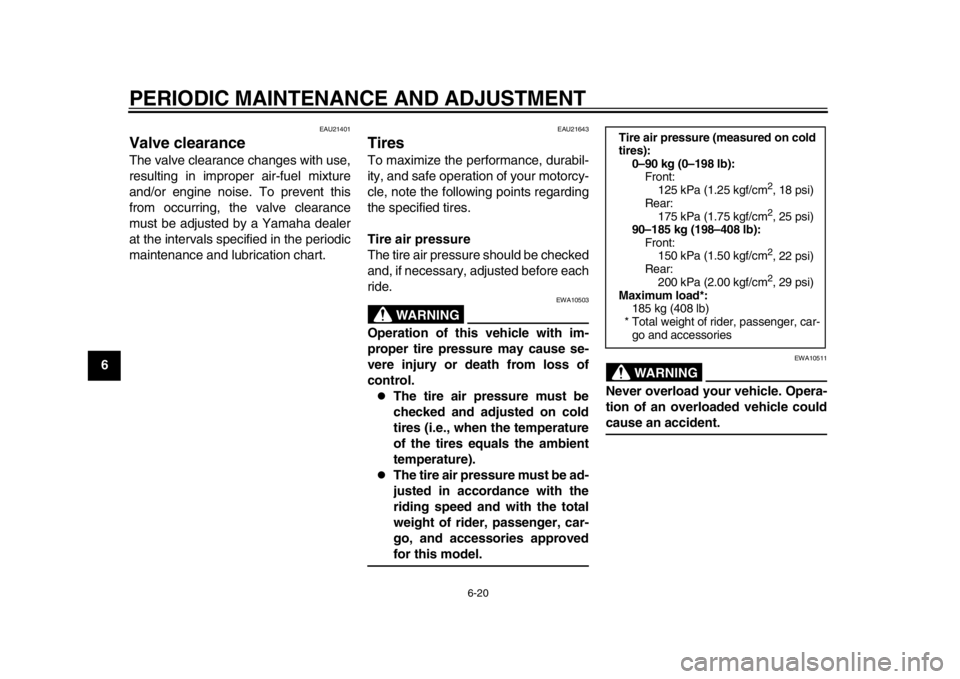
PERIODIC MAINTENANCE AND ADJUSTMENT
6-20
1
2
3
4
56
7
8
9
EAU21401
Valve clearance The valve clearance changes with use,
resulting in improper air-fuel mixture
and/or engine noise. To prevent this
from occurring, the valve clearance
must be adjusted by a Yamaha dealer
at the intervals specified in the periodic
maintenance and lubrication chart.
EAU21643
Tires To maximize the performance, durabil-
ity, and safe operation of your motorcy-
cle, note the following points regarding
the specified tires.
Tire air pressure
The tire air pressure should be checked
and, if necessary, adjusted before each
ride.
WARNING
EWA10503
Operation of this vehicle with im-
proper tire pressure may cause se-
vere injury or death from loss of
control.
The tire air pressure must be
checked and adjusted on cold
tires (i.e., when the temperature
of the tires equals the ambient
temperature).
The tire air pressure must be ad-
justed in accordance with the
riding speed and with the total
weight of rider, passenger, car-
go, and accessories approvedfor this model.
WARNING
EWA10511
Never overload your vehicle. Opera-
tion of an overloaded vehicle couldcause an accident.Tire air pressure (measured on cold
tires):0– 90 kg (0 –198 lb):
Front:
125 kPa (1.25 kgf/cm
2, 18 psi)
Rear: 175 kPa (1.75 kgf/cm2, 25 psi)
90 –185 kg (198 –408 lb):
Front: 150 kPa (1.50 kgf/cm2, 22 psi)
Rear: 200 kPa (2.00 kgf/cm2, 29 psi)
Maximum load*:
185 kg (408 lb)
* Total weight of rider, passenger, car- go and accessories
32D-9-E8.book 20 ページ 2011年6月28日 火曜日 午前10時27分
Page 63 of 98
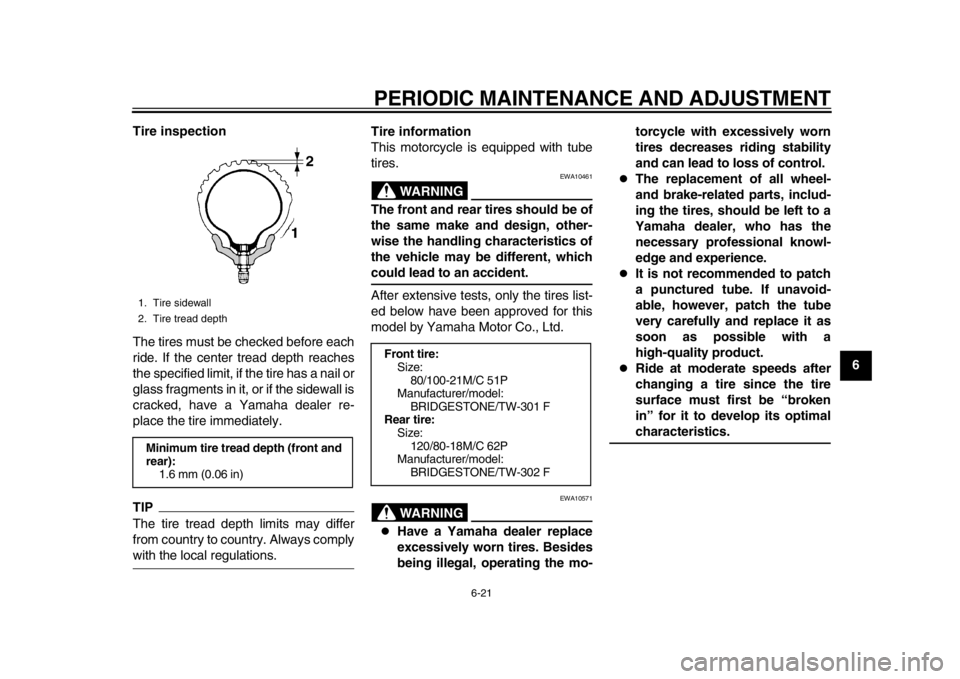
PERIODIC MAINTENANCE AND ADJUSTMENT
6-21
2
3
4
567
8
9
Tire inspection
The tires must be checked before each
ride. If the center tread depth reaches
the specified limit, if the tire has a nail or
glass fragments in it, or if the sidewall is
cracked, have a Yamaha dealer re-
place the tire immediately.
TIPThe tire tread depth limits may differ
from country to country. Always complywith the local regulations. Tire information
This motorcycle is equipped with tube
tires.
WARNING
EWA10461
The front and rear tires should be of
the same make and design, other-
wise the handling characteristics of
the vehicle may be different, whichcould lead to an accident.
After extensive tests, only the tires list-
ed below have been approved for this
model by Yamaha Motor Co., Ltd.
WARNING
EWA10571
Have a Yamaha dealer replace
excessively worn tires. Besides
being illegal, operating the mo-torcycle with excessively worn
tires decreases riding stability
and can lead to loss of control.
The replacement of all wheel-
and brake-related parts, includ-
ing the tires, should be left to a
Yamaha dealer, who has the
necessary professional knowl-
edge and experience.
It is not recommended to patch
a punctured tube. If unavoid-
able, however, patch the tube
very carefully and replace it as
soon as possible with a
high-quality product.
Ride at moderate speeds after
changing a tire since the tire
surface must first be “broken
in” for it to develop its optimalcharacteristics.
1. Tire sidewall
2. Tire tread depthMinimum tire tread depth (front and
rear):
1.6 mm (0.06 in)
Front tire:Size:
80/100-21M/C 51P
Manufacturer/model: BRIDGESTONE/TW-301 F
Rear tire: Size:120/80-18M/C 62P
Manufacturer/model: BRIDGESTONE/TW-302 F
32D-9-E8.book 21 ページ 2011年6月28日 火曜日 午前10時27分
Page 64 of 98

PERIODIC MAINTENANCE AND ADJUSTMENT
6-22
1
2
3
4
56
7
8
9
EAU21943
Spoke wheels
WARNING
EWA10610
The wheels on this model are not de-
signed for use with tubeless tires.
Do not attempt to use tubeless tireson this model.
To maximize the performance, durabil-
ity, and safe operation of your motorcy-
cle, note the following points regarding
the specified wheels.
The wheel rims should be checked
for cracks, bends, warpage or oth-
er damage, and the spokes for
looseness or damage before each
ride. If any damage is found, have
a Yamaha dealer replace the
wheel. Do not attempt even the
smallest repair to the wheel. A de-
formed or cracked wheel must be
replaced.
The wheel should be balanced
whenever either the tire or wheel
has been changed or replaced. An
unbalanced wheel can result in
poor performance, adverse han-
dling characteristics, and a short-
ened tire life.
EAU48373
Adjusting the clutch lever free
play The clutch lever free play should mea-
sure 10.0–15.0 mm (0.39– 0.59 in) as
shown. Periodically check the clutch le-
ver free play and, if necessary, adjust it
as follows. 1. Slide the rubber cover back at the clutch lever.
2. Loosen the locknut.
3. To increase the clutch lever free play, turn the clutch lever free play
adjusting bolt in direction (a). To
decrease the clutch lever free play,
turn the adjusting bolt in direction
(b).
TIPIf the specified clutch lever free play
could be obtained as described above,skip steps 4 –7.
4. Fully turn the adjusting bolt in di- rection (a) to loosen the clutch ca-
ble.
5. Slide the rubber cover back further down the clutch cable, and then
loosen the locknut.
6. To increase the clutch lever free play, turn the clutch lever free play
adjusting nut in direction (a). To
decrease the clutch lever free play,1. Clutch lever free play
2. Locknut (clutch lever)
3. Clutch lever free play adjusting bolt
4. Rubber cover
3
2
1
4
(a)(b)
32D-9-E8.book 22 ページ 2011年6月28日 火曜日 午前10時27分
Page 65 of 98
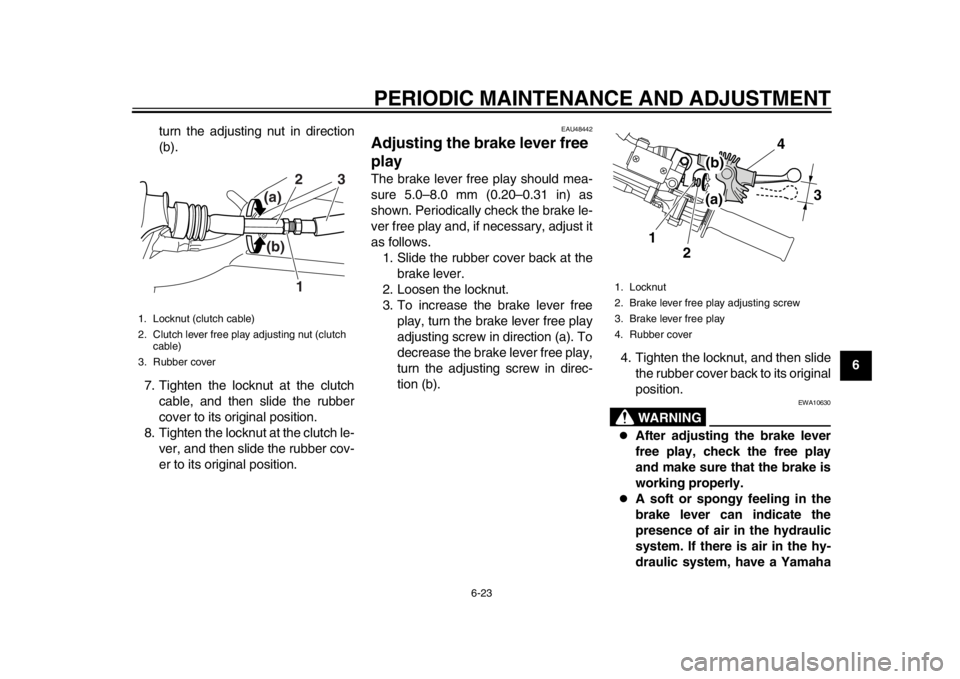
PERIODIC MAINTENANCE AND ADJUSTMENT
6-23
2
3
4
567
8
9
turn the adjusting nut in direction
(b).
7. Tighten the locknut at the clutch cable, and then slide the rubber
cover to its original position.
8. Tighten the locknut at the clutch le- ver, and then slide the rubber cov-
er to its original position.
EAU48442
Adjusting the brake lever free
play The brake lever free play should mea-
sure 5.0– 8.0 mm (0.20– 0.31 in) as
shown. Periodically check the brake le-
ver free play and, if necessary, adjust it
as follows. 1. Slide the rubber cover back at the brake lever.
2. Loosen the locknut.
3. To increase the brake lever free play, turn the brake lever free play
adjusting screw in direction (a). To
decrease the brake lever free play,
turn the adjusting screw in direc-
tion (b). 4. Tighten the locknut, and then slide
the rubber cover back to its original
position.
WARNING
EWA10630
After adjusting the brake lever
free play, check the free play
and make sure that the brake is
working properly.
A soft or spongy feeling in the
brake lever can indicate the
presence of air in the hydraulic
system. If there is air in the hy-
draulic system, have a Yamaha
1. Locknut (clutch cable)
2. Clutch lever free play adjusting nut (clutch cable)
3. Rubber cover
1
2
3
(a)
(b)
1. Locknut
2. Brake lever free play adjusting screw
3. Brake lever free play
4. Rubber cover
3
1 2
4
(b)
(a)
32D-9-E8.book 23 ページ 2011年6月28日 火曜日 午前10時27分
Page 66 of 98
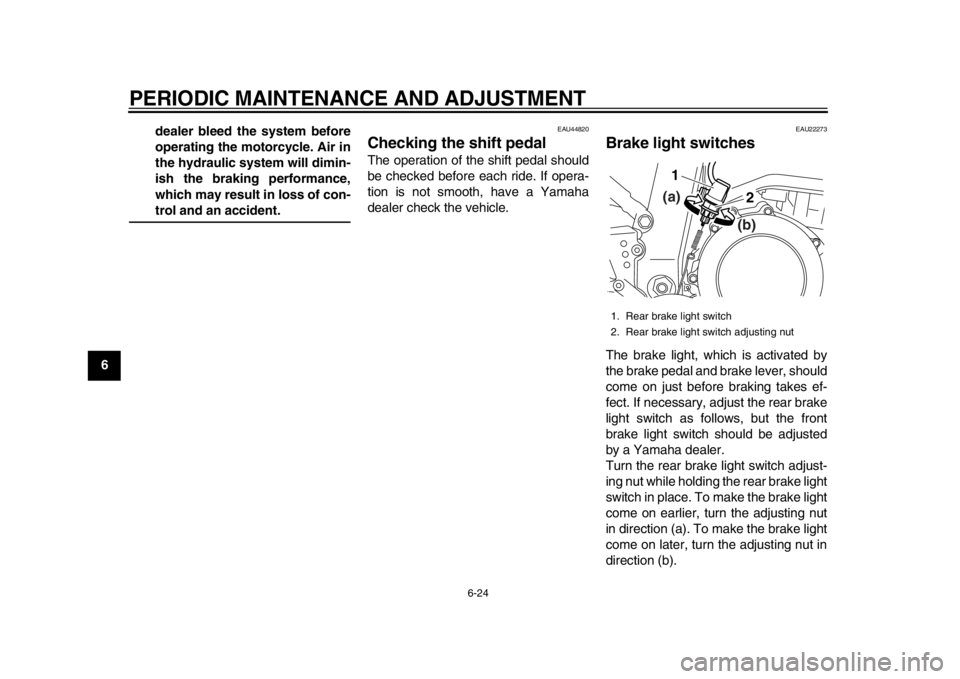
PERIODIC MAINTENANCE AND ADJUSTMENT
6-24
1
2
3
4
56
7
8
9dealer bleed the system before
operating the motorcycle. Air in
the hydraulic system will dimin-
ish the braking performance,
which may result in loss of con-
trol and an accident.
EAU44820
Checking the shift pedal The operation of the shift pedal should
be checked before each ride. If opera-
tion is not smooth, have a Yamaha
dealer check the vehicle.
EAU22273
Brake light switches The brake light, which is activated by
the brake pedal and brake lever, should
come on just before braking takes ef-
fect. If necessary, adjust the rear brake
light switch as follows, but the front
brake light switch should be adjusted
by a Yamaha dealer.
Turn the rear brake light switch adjust-
ing nut while holding the rear brake light
switch in place. To make the brake light
come on earlier, turn the adjusting nut
in direction (a). To make the brake light
come on later, turn the adjusting nut in
direction (b).1. Rear brake light switch
2. Rear brake light switch adjusting nut
1
2(b)
(a)
32D-9-E8.book 24 ページ 2011年6月28日 火曜日 午前10時27分
Page 67 of 98
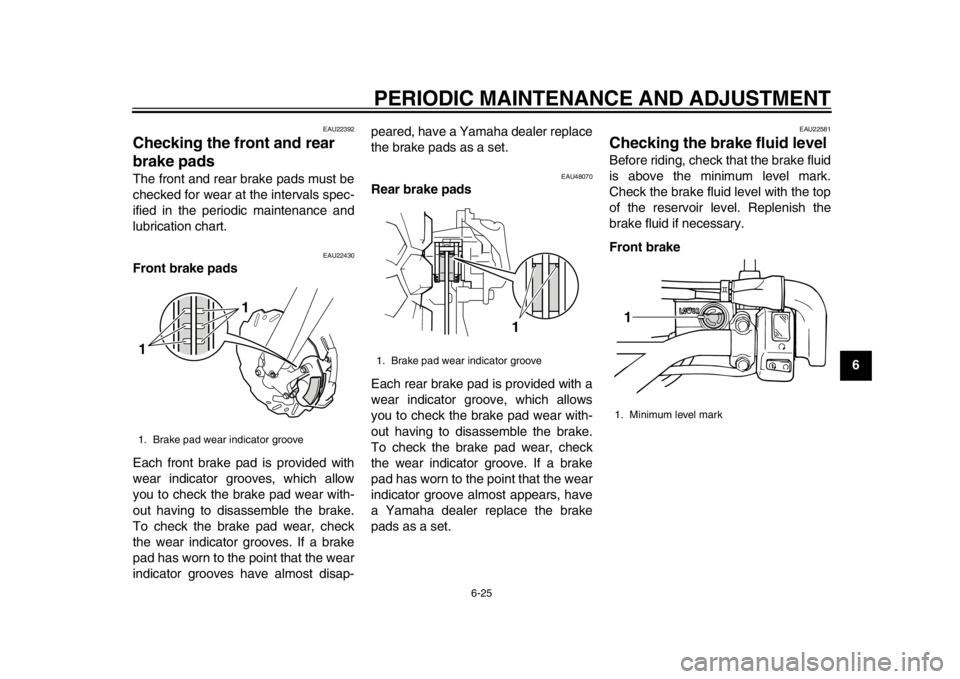
PERIODIC MAINTENANCE AND ADJUSTMENT
6-25
2
3
4
567
8
9
EAU22392
Checking the front and rear
brake pads The front and rear brake pads must be
checked for wear at the intervals spec-
ified in the periodic maintenance and
lubrication chart.
EAU22430
Front brake pads
Each front brake pad is provided with
wear indicator grooves, which allow
you to check the brake pad wear with-
out having to disassemble the brake.
To check the brake pad wear, check
the wear indicator grooves. If a brake
pad has worn to the point that the wear
indicator grooves have almost disap- peared, have a Yamaha dealer replace
the brake pads as a set.
EAU48070
Rear brake pads
Each rear brake pad is provided with a
wear indicator groove, which allows
you to check the brake pad wear with-
out having to disassemble the brake.
To check the brake pad wear, check
the wear indicator groove. If a brake
pad has worn to the point that the wear
indicator groove almost appears, have
a Yamaha dealer replace the brake
pads as a set.
EAU22581
Checking the brake fluid level Before riding, check that the brake fluid
is above the minimum level mark.
Check the brake fluid level with the top
of the reservoir level. Replenish the
brake fluid if necessary.
Front brake
1. Brake pad wear indicator groove1
1
1. Brake pad wear indicator groove
1
1. Minimum level mark1
32D-9-E8.book 25 ページ 2011年6月28日 火曜日 午前10時27分
Page 68 of 98
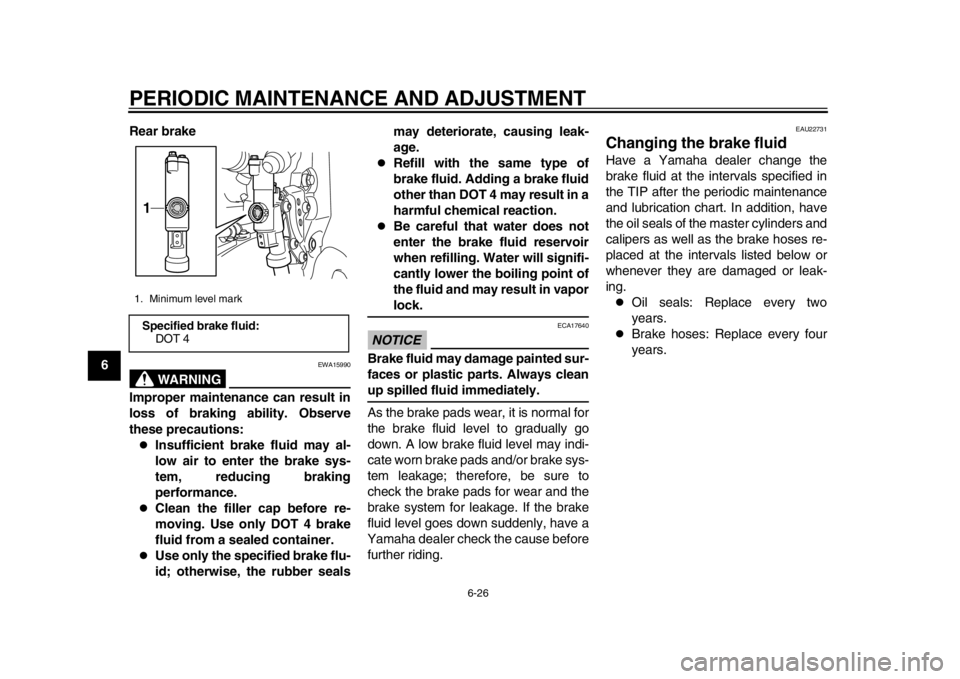
PERIODIC MAINTENANCE AND ADJUSTMENT
6-26
1
2
3
4
56
7
8
9Rear brake
WARNING
EWA15990
Improper maintenance can result in
loss of braking ability. Observe
these precautions:
Insufficient brake fluid may al-
low air to enter the brake sys-
tem, reducing braking
performance.
Clean the filler cap before re-
moving. Use only DOT 4 brake
fluid from a sealed container.
Use only the specified brake flu-
id; otherwise, the rubber seals may deteriorate, causing leak-
age.
Refill with the same type of
brake fluid. Adding a brake fluid
other than DOT 4 may result in a
harmful chemical reaction.
Be careful that water does not
enter the brake fluid reservoir
when refilling. Water will signifi-
cantly lower the boiling point of
the fluid and may result in vaporlock.
NOTICE
ECA17640
Brake fluid may damage painted sur-
faces or plastic parts. Always cleanup spilled fluid immediately.
As the brake pads wear, it is normal for
the brake fluid level to gradually go
down. A low brake fluid level may indi-
cate worn brake pads and/or brake sys-
tem leakage; therefore, be sure to
check the brake pads for wear and the
brake system for leakage. If the brake
fluid level goes down suddenly, have a
Yamaha dealer check the cause before
further riding.
EAU22731
Changing the brake fluid Have a Yamaha dealer change the
brake fluid at the intervals specified in
the TIP after the periodic maintenance
and lubrication chart. In addition, have
the oil seals of the master cylinders and
calipers as well as the brake hoses re-
placed at the intervals listed below or
whenever they are damaged or leak-
ing.
Oil seals: Replace every two
years.
Brake hoses: Replace every four
years.
1. Minimum level markSpecified brake fluid:
DOT 41
32D-9-E8.book 26 ページ 2011年6月28日 火曜日 午前10時27分
Page 69 of 98
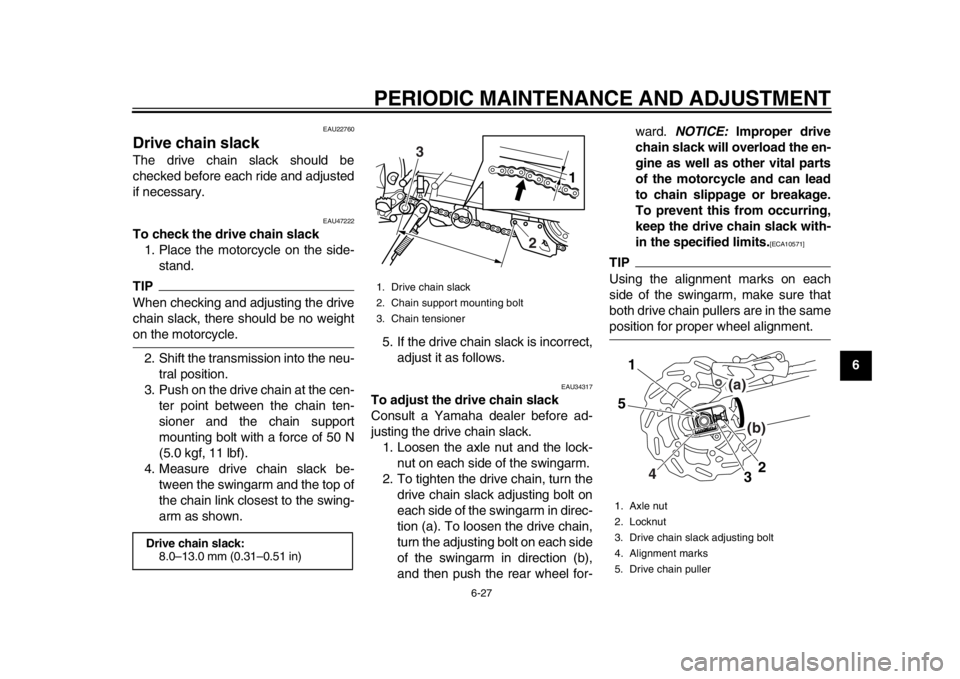
PERIODIC MAINTENANCE AND ADJUSTMENT
6-27
2
3
4
567
8
9
EAU22760
Drive chain slack The drive chain slack should be
checked before each ride and adjusted
if necessary.
EAU47222
To check the drive chain slack1. Place the motorcycle on the side- stand.TIPWhen checking and adjusting the drive
chain slack, there should be no weighton the motorcycle.
2. Shift the transmission into the neu- tral position.
3. Push on the drive chain at the cen- ter point between the chain ten-
sioner and the chain support
mounting bolt with a force of 50 N
(5.0 kgf, 11 lbf).
4. Measure drive chain slack be- tween the swingarm and the top of
the chain link closest to the swing-
arm as shown. 5. If the drive chain slack is incorrect,
adjust it as follows.
EAU34317
To adjust the drive chain slack
Consult a Yamaha dealer before ad-
justing the drive chain slack.1. Loosen the axle nut and the lock- nut on each side of the swingarm.
2. To tighten the drive chain, turn the drive chain slack adjusting bolt on
each side of the swingarm in direc-
tion (a). To loosen the drive chain,
turn the adjusting bolt on each side
of the swingarm in direction (b),
and then push the rear wheel for- ward.
NOTICE: Improper drive
chain slack will overload the en-
gine as well as other vital parts
of the motorcycle and can lead
to chain slippage or breakage.
To prevent this from occurring,
keep the drive chain slack with-
in the specified limits.
[ECA10571]
TIPUsing the alignment marks on each
side of the swingarm, make sure that
both drive chain pullers are in the sameposition for proper wheel alignment.
Drive chain slack: 8.0 –13.0 mm (0.31 –0.51 in)
1. Drive chain slack
2. Chain support mounting bolt
3. Chain tensioner
1
3
2
1. Axle nut
2. Locknut
3. Drive chain slack adjusting bolt
4. Alignment marks
5. Drive chain puller
15
32
4
(b)
(a)
32D-9-E8.book 27 ページ 2011年6月28日 火曜日 午前10時27分
Page 70 of 98
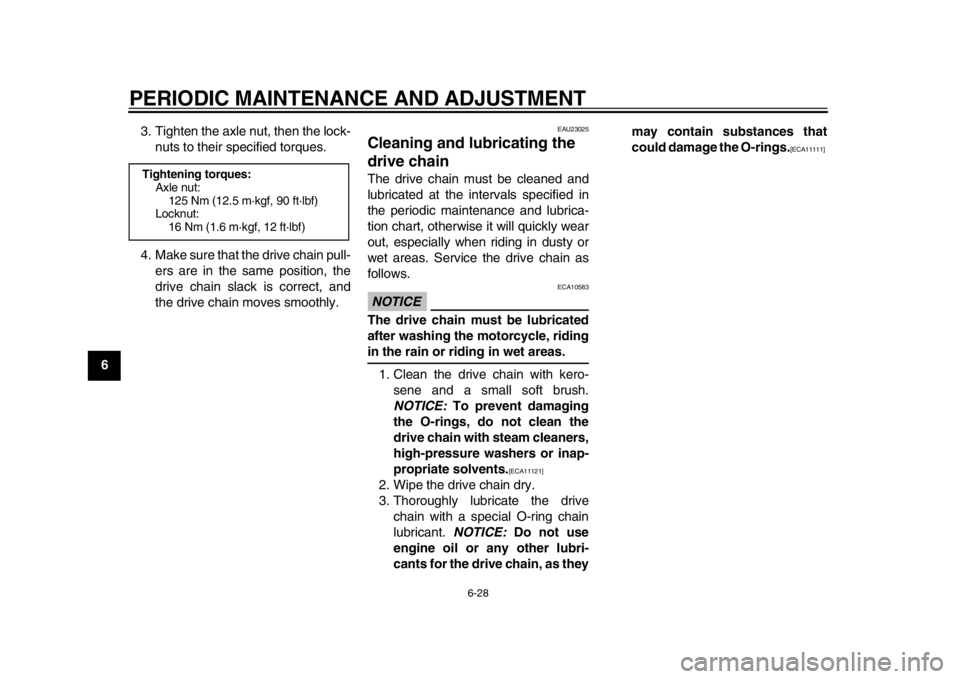
PERIODIC MAINTENANCE AND ADJUSTMENT
6-28
1
2
3
4
56
7
8
93. Tighten the axle nut, then the lock-
nuts to their specified torques.
4. Make sure that the drive chain pull- ers are in the same position, the
drive chain slack is correct, and
the drive chain moves smoothly.
EAU23025
Cleaning and lubricating the
drive chain The drive chain must be cleaned and
lubricated at the intervals specified in
the periodic maintenance and lubrica-
tion chart, otherwise it will quickly wear
out, especially when riding in dusty or
wet areas. Service the drive chain as
follows.NOTICE
ECA10583
The drive chain must be lubricated
after washing the motorcycle, ridingin the rain or riding in wet areas.
1. Clean the drive chain with kero- sene and a small soft brush.
NOTICE: To prevent damaging
the O-rings, do not clean the
drive chain with steam cleaners,
high-pressure washers or inap-
propriate solvents.
[ECA11121]
2. Wipe the drive chain dry.
3. Thoroughly lubricate the drive chain with a special O-ring chain
lubricant. NOTICE: Do not use
engine oil or any other lubri-
cants for the drive chain, as they may contain substances that
could damage the O-rings.
[ECA11111]
Tightening torques:
Axle nut:125 Nm (12.5 m·kgf, 90 ft·lbf)
Locknut: 16 Nm (1.6 m·kgf, 12 ft·lbf)
32D-9-E8.book 28 ページ 2011年6月28日 火曜日 午前10時27分